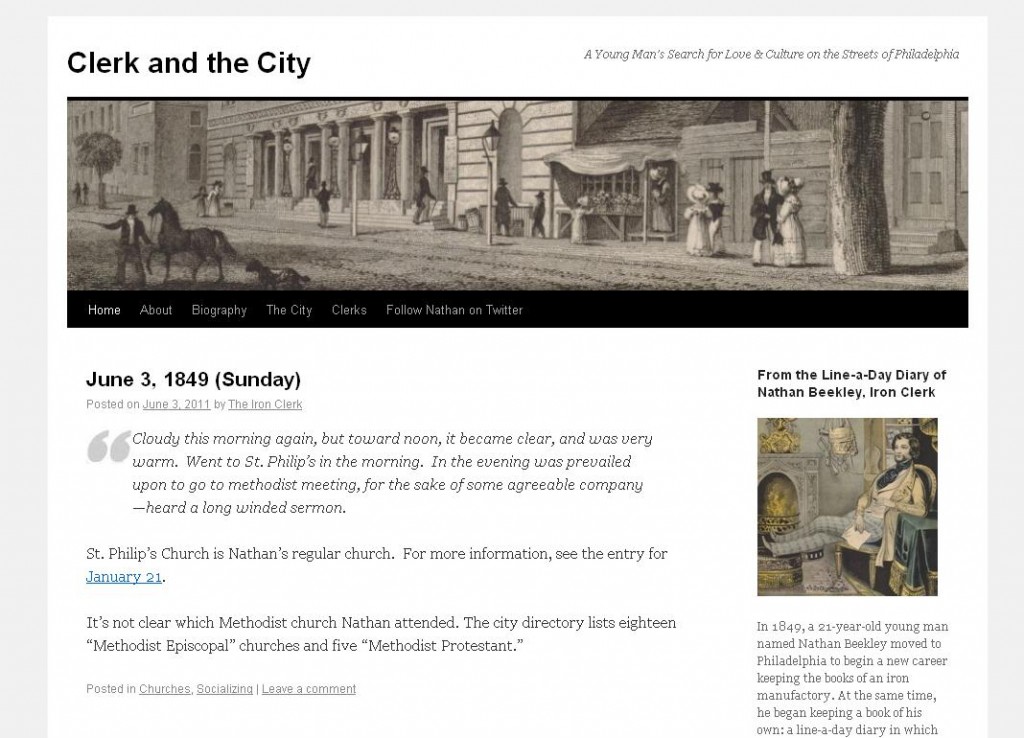It must have been personal interest that drew my eye to this one item on the shelf, “The Temptations of City Life: A Voice to Young Men Seeking a Home and Fortune, in Large Towns and Cities,” Tracts for the Cities — No. 3 (New York, 1849) [AAS online catalog record]. While I am not a young man seeking a home and fortune, my husband and I are currently debating purchasing a home in the Worcester area. I am firmly on the side of city living. He, however, is advocating for a rural retreat. The conversation goes something like this:
Me: “Look at this one — it’s perfect!”
Him [glancing at the computer screen before quickly turning away]: “There’s no yard. Your neighbors are going to be looking right in your windows.”
Me: “But we would be able to walk to the grocery store and to work and to the museum.”
Personally, I have come to love the arts and culture available in Worcester. We have wonderful restaurants and vibrant events like stART on the street. We have beautiful Elm Park, a world-class art museum, and a similarly world-class historical research library for the study of early America (if I do say so myself). But enough Worcester boosterism.
These are the factors I find most tempting about city life. What were considered the urban temptations 150 years ago?
A Night on the Town
Worcester is no New York City (and NYC is always “the city” in these type of tracts), but the author of this pamphlet assures his readers that his description can be more widely applied to other large towns and cities. While I turn to Worcester Magazine or Worcester Living to make my plans for weekend events in the city, this tract describes a similar start to the evening for a typical young clerk in the city in 1849:
“After his evening meal, he may read the following, or some similar advertisement in the paper: ‘Citizens and strangers wishing to spend an hour comfortably, in a quiet and beautifully-furnished retreat, where the best of liquors, wines, and segars [sic], are offered, and where they can have access to all the papers of the day, besides the English and American pictorials, are respectfully solicited to drop in at No. _, _ street.'”
 To find out what a real young clerk did with his city evenings in 1849, you can read our Clerk and the City blog which contains the daily diary entries of a clerk in Philadelphia named Nathan Beekley (you can also follow Nathan, or The Iron Clerk, as he is known on Twitter). According to the tract “The Temptations of City Life,” this is what a young clerk like Nathan would have found to tempt him on the streets of a city like New York or Philadelphia:
To find out what a real young clerk did with his city evenings in 1849, you can read our Clerk and the City blog which contains the daily diary entries of a clerk in Philadelphia named Nathan Beekley (you can also follow Nathan, or The Iron Clerk, as he is known on Twitter). According to the tract “The Temptations of City Life,” this is what a young clerk like Nathan would have found to tempt him on the streets of a city like New York or Philadelphia:
“On almost every corner, some saloon brilliantly lighted, opens its attractive portal
s. It is furnished on a scale of the richest luxury, with splendid mirrors, costly divans, easy lounges, and tables covered with late journals and pictorial works. Paintings of great artistic merit, arranged on the walls, and exhibiting the nude and seductive forms of female beauty, appeal to the ardent passions of youth; and corresponding music in sweetest strains steals upon his senses. Often, to add to the attractions of these places, varying entertainments, of the buffoon, danseuse, and the ballad-singer, are furnished. Captivated by such scenes, unsuspecting youth repeats his visits, finds other similar resorts, and finally is in the habit of being abroad every night, and is found at his boarding-house only for his meals and late lodgings. He visits all the distinguished saloons, refectories, bowling-alleys, theatres, gambling-hells, and other abodes of affiliated infamy.”
One can almost hear the jolly ballads, smell the wafting aromas, and see the bright light all spilling out onto the city streets as each of these temptations is described in full sensual detail. Later, the tract goes on to describe the necessary components for a night out on the town.
- Food for the “besotted epicure”:
“Undue relish for the luxuries of the table is catered to by the productions of all climes served upon the most approved methods of the culinary art, and at all hours of the night and day. “Restaurants,” “cafes,” refectories,” and “oyster-saloons,” in every grade of meanness or respectability and splendor, are found on almost every corner of the streets… At length he becomes a miserable dyspeptic, a besotted epicure, and is devoted to all sensual excesses.”
- Drink in “porticoes of perdition”:
“Appetite for ardent spirits is appealed to from scores of splendid saloons and low porter-houses. The devote of the cup has no trouble, as in the country, to keep his sideboard supplied with the choicest liquors. They are sold in a hundred places within as many rods, and he can, by turning a comer, or walking a few blocks, replenish his stores or obtain a single glass. These places, made attractive by fine paintings, music, and diversified entertainments of wit, and song, and dance, have introduced so many upon the broad road to ruin, that they are recognised as the porticoes of perdition.”
- Entertainments for “another class of passions”:
“Hundreds of abodes of infamy are opened throughout the city, appealing to another class of passions; their hired emissaries are abroad in the city and country, to decoy the unwary and the friendless. Directories and cards are secretly distributed in offices, places of business, and to strangers as they reach the city. Placards along the streets, and advertisements in the journals, assure the passionate and adventurous youth that crime and villany may be pursued at reduced hazards. And fascinating but fallen women wait at the corners of the streets, and with honeyed words make the overtures of damning sin.”
All the earlier places of vice lead up to the last one, that number-one worry of the tract’s author and nineteenth-century mothers everywhere: the brothel. It represented the ultimate extension of what was perceived of as the primary danger of the city, and its sharpest contrast from rural life: the anonymity its streets offered. Anonymity could allow one to slip into sin among “the dark mazes and perilous labyrinths of a modern Sodom.” The city tract describes the unique character of a city thus:
“In its disguised activity, gayety, and unrestrained license, a city is one vast masquerade entertainment. Through its spacious avenues, gardens, and parks — its splendid saloons and halls of amusement — thronging multitudes pass and repass, unknowing and unknown, like those in the gay dance; and often the attitudes, airs, and looks assumed, exhibit a degree of wantonness, or want of circumspection, that are preliminary to, and abet every course of vice.”
Yet, if you leave out the wantonness and vice, does this description really sound that bad? Or, to put it another way, does it sound likely to dissuade a young man? While this tract is ostensibly directed at encouraging young men in particular not to leave the safe influences of their families and rural homes, the evocative language must have produced the opposite effect on at least some of his original audience.
Arguments like those presented in this city tract certainly didn’t deter the real life clerk, Nathan Beekley, mentioned above. His diary in AAS’s collections [AAS online catalog record] describes his first year living in Philadelphia. It shows he sampled a wide variety of entertainments on offer, but also the same names of companions consistently appear. This seems to indicate that, in actual experience, the anonymity of the city was less absolute than the city tract would lead us to believe. (Of course, Beekley was in Philadelphia, a city whose population in 1850 (121,000) was closer to the population of Worcester in 2010 (183,000) than it was to New York in 1850 (696,000), according to the federal census records.)
The question of whether the cultural attractions and convenience of living in a crowded city outweighed its dangers and hassles appears to be a perennial one, although the changing cultural perceptions of what those crowds mean is historically interesting. As I mentioned at the beginning of this post, my husband’s main complaint about the city today is that you’re so close to your neighbors that people will be looking in on you. Ironically, when “The Temptations of City Life” was written in 1849, the population density of the city was seen as a problem for the exact opposite reason: the anonymity of the crowded streets and the separation from your family of birth was understood to mean that people would not be “looking in on you” to keep you honest and virtuous. The same fact, population density, was deployed to represent opposite ideas (although both were presented as arguments against city living).
On the positive side, if the city is “one vast masquerade entertainment,” it means you’ll never get bored. The 1849 city tract declares, “Entrance upon city life is not merely one great change, but an introduction to a perpetual succession of changes.” Perhaps this is true not only for individuals coming to the city, but also for our cities themselves.
And isn’t the ever-present possibility of change and renewal a great argument for city living? At least I’ll try to convince my husband it is.




I live in the “urban core” of Worcester (the Village of Piedmont?) and enjoy it. I appreciate being able to walk to several parks (Elm Park is closest, unless you consider the small park, Winslow Park, at the end of my street), as well as the grocery store, many restaurants (Park Ave, Highland St, Canal District, Shrewsbury St), pharmacies, colleges, etc. Worcester is the perfect pace for me – enough events and things going on to keep me interested but not overwhelmed.
I enjoyed this post very much (as I do all your posts), and love Nathan’s blog.This is such a wonderful way for old “voices” in diaries and journals to find a new life, and a new audience. Any chance you might be doing the same for Patty Rogers, too?
I’ve mentioned & linked over at my own blog, Two Nerdy History Girls: http://bit.ly/jc8YO3